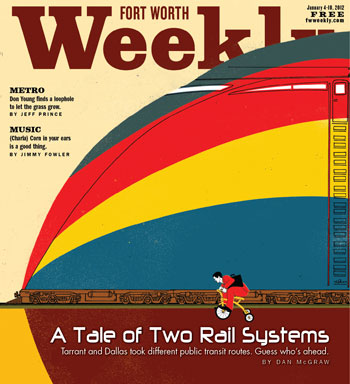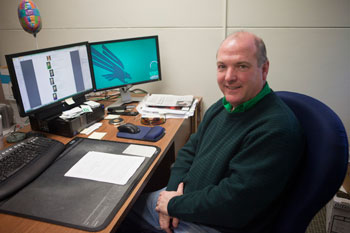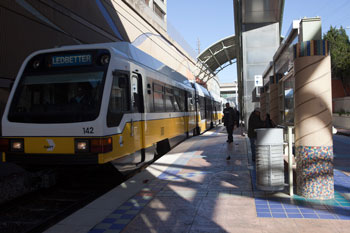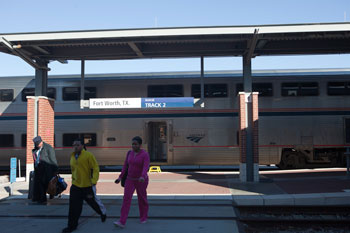Anyone who has ever tried taking the Trinity Railway Express to Dallas-Fort Worth International Airport knows how poorly planned this commuter rail line is.
The seats are comfortable enough, and the ride from downtown Fort Worth to the CentrePort Station just south of the airport takes only about a half-hour.
 But don’t get too comfortable, because actually getting to your airport gate involves leaving the train at CentrePort, getting on a bus, getting off that bus at the airport rental-car lot, and getting on another bus that takes you to the terminal. Total: an hour and a half and three sessions of lugging bags on and off before travelers actually get to the check-in lines at the airport.
But don’t get too comfortable, because actually getting to your airport gate involves leaving the train at CentrePort, getting on a bus, getting off that bus at the airport rental-car lot, and getting on another bus that takes you to the terminal. Total: an hour and a half and three sessions of lugging bags on and off before travelers actually get to the check-in lines at the airport.
“It is a mess,” said Michael Morris, director of transportation for the North Central Texas Council of Governments. “It’s silly to have to take two buses to get you to the terminals. What is happening out there is unacceptable.”
The TRE line has run between the downtowns of Fort Worth and Dallas for a decade, and in that time no one has figured out how to make it into an efficient way to deliver travelers to one of the busiest airports in the country. There currently is no direct public-transit route to DFW airport from either city.
The TRE/airport situation does provide something valuable, however: a lesson in the past, present, and future of mass transit in North Texas and a partial explanation for why public transportation looks vastly different today in Dallas and Fort Worth.
The TRE is a joint venture of the Fort Worth Transportation Authority (The T) and Dallas Area Rapid Transit (DART), with about 8,600 riders a day. Though the two agencies are partners in the line, they share little in the way of a common philosophy about mass transit.
To The T, the future of mass transit looks a lot like the TRE — that is, rail systems that run on freight lines and focus on getting people from Point A to Point B. They have few stops in between and little in the way of housing, retail, or office development along the way. Especially in Tarrant County, TRE stops tend to be surrounded by woods and park-and-ride lots rather than shopping or entertainment developments.
The first commuter project that The T plans to do on its own is a line from southwest Fort Worth to the airport, with stops only at the Stockyards and in Grapevine. The second would be a line from downtown Fort Worth to the Alliance Airport area, with intermediate stops only at the Stockyards and the Texas Motor Speedway. The third would run out East Lancaster Avenue from downtown to the historic Handley neighborhood.
DART meanwhile has concentrated its efforts on light-rail projects. Light-rail trains runs along their own lines and make frequent stops. Because the lines follow highways and surface streets, they are much more likely than commuter trains to be used by residents to get around their city for multiple purposes. DART now has more than 70 miles of light-rail lines and plans to build another 20 miles or so in the next decade.
The DART plan has allowed it to link south Dallas and Plano, for example, and to get people from Denton or Irving to downtown Dallas and many other places. The key to DART’s success is its multiple stops. Agency officials are finding that, more and more, people are using the transit system not only to get to and from work but to go out to eat or see a movie and for things like going to the State Fair or loading a bike on board to get to the trails around White Rock Lake.
The result is not only more riders — it’s much more economic development. DART has shown that real estate developers and investors will follow the light-rail lines. Freight commuter lines being planned by The T don’t use that model at all. Hence DART gets hundred-million-dollar grants from the federal government for its future plans, while The T is still waiting.
Of course, as with any public project, form goes back to funding. And about 30 years ago, Dallas decided to go in one direction and Fort Worth another.
********
Dallas attorney Walt Humann is credited with the founding of DART. He has been a leading advocate of mass transit in North Texas for decades. In the late 1970s, Humann met with Fort Worth leadership, and together they came up with a plan to form a regional mass-transit system to include Dallas, Tarrant, Collin, and Denton counties. He met with former Mayor Bob Bolen and businessman Ed Bass, and they decided to put a one-cent sales-tax hike before voters in the four counties in 1980.
 “It failed miserably, because we didn’t do our homework,” Humann said. “Our problem was that we didn’t explain what the taxpayers would get for their contribution. We never got it out there right that this would be a seamless system uniting the whole region, mixing light and commuter rail, buses and HOV lanes, solving traffic issues with a whole host of options.”
“It failed miserably, because we didn’t do our homework,” Humann said. “Our problem was that we didn’t explain what the taxpayers would get for their contribution. We never got it out there right that this would be a seamless system uniting the whole region, mixing light and commuter rail, buses and HOV lanes, solving traffic issues with a whole host of options.”
Bolen and Humann took another shot at mass transit in 1983. But this time they decided against the regional approach, instead separating Dallas and Tarrant county systems. Dallas would go first, in August 1983, and Tarrant County in November of that year.
“We recruited business leaders and had a full-bore political grass-roots movement,” Humann said. “We sent out information informing people that this was an important long-term investment.” The sales tax hike passed easily in Dallas County, and 15 cities came on board.
Fort Worth leaders took a different approach. Because the one-cent tax hike had failed miserably in Fort Worth, they scaled it back to a half-cent. The other half-cent would go toward funding a crime-control district. Both passed in Fort Worth, but only four other Tarrant cities approved the sales-tax hike for mass transit. Over time, three of those cities pulled out, leaving just Fort Worth and Richland Hills.
The decision by Fort Worth not to go after a full cent for mass-transit funding had an impact that is still being felt. DART has been able to build one of the largest light-rail systems in the country. The T, on the other hand, has had no choice but to maintain a bus system whose main purpose is to provide basic transportation to poor folks without cars.
The difference in ridership between the two systems is a powerful argument for investing in infrastructure. DART has more than 250,000 weekday riders, including about 60,000 a day who board light rail. The T has about 25,000 riding its buses daily. The national average for people using mass transit to commute to work is five percent of the population. Dallas comes in at 2.7 percent, Fort Worth at 0.9 percent.
Even more striking is the difference in economic development that Dallas has experienced from light rail, especially around Mockingbird Station, four miles north of downtown. Since 1999, within a five-minute walking-distance radius, 600,000 square feet of development has been added, including more than 90 shops and restaurants and more than 200 loft-style apartments. Property-tax revenues have risen by more than 25 percent.
“Whenever I give talks around the country about the importance of mass transit, everyone wants to hear about the developments near Mockingbird Station,” Humann said. “It’s just a sign that people are changing. They want to live near mass transit so they don’t have to use their cars all the time. They like to walk to go out to eat or see a movie. And along with that comes less traffic congestion and cleaner air.”
As for Fort Worth lagging far behind other big cities in its mass-transit system, Humann said, “It is all about funding.”
Over the past two legislative sessions, North Texas leaders — including Humann, Morris, and Fort Worth council member Jungus Jordan — have lobbied for a mechanism that would allow areas like the Metroplex to go above (or get around) the state’s 8.25 percent cap on the sales tax, to fund transportation projects. They envision a lot of different ways to raise transit money, from a tax on car repairs to higher fees for vehicle registration. Thus far, tax-wary state officials have balked.
 As long as the Tarrant cities have only a half-cent of sales-tax revenue to devote to transit projects, Humann said, “the system they have is about all they can afford.” On the other hand, he said, their plans for commuter rail may draw more cities into the system, as has happened with Grapevine.
As long as the Tarrant cities have only a half-cent of sales-tax revenue to devote to transit projects, Humann said, “the system they have is about all they can afford.” On the other hand, he said, their plans for commuter rail may draw more cities into the system, as has happened with Grapevine.
“But if you are going to be a world-class city, you have to have a great mass- transit system,” Humann said. “I think Fort Worth is at a point right now where that issue is gaining more importance.”
********
One might think that the solution for better airport access from the TRE would be for DART and The T to fund a direct bus route or build a relatively short spur line from CentrePort to the airport terminals. But that’s not in the plans. What is in the plan is for each agency to build its own rail line to the airport.
DART’s Orange Line extension to the airport, already under construction, goes through Irving and Carrollton. Total cost is $430 million, and work is due to be completed by 2014.
The T’s plan is a commuter rail train, to be called TEXRail, running on leased freight tracks, from southwest Fort Worth through downtown and then into the airport from Grapevine. Total price tag is estimated at $600 million, and The T has applied to the federal government for a grant to pay half of that. Without federal funds, TEXRail is a no-go. Given the extent and seriousness of federal budget issues these days, with factions in Congress fighting over seemingly every project, chances of this project actually getting built are rated as slim.
Light rail is the most expensive form of mass transit, at $60 million to $80 million per mile compared to $20 million to $25 million for commuter rail. Most of the difference is due to the need to build new dedicated lines for light rail versus leasing existing freight lines for commuter rail.
Terry Clower, an economist at the University of North Texas, estimated that the Orange Line will bring about $4 billion in new development over the next two decades, mostly at its six intermediate stops between Love Field and DFW.
TEXRail, with a route through industrial areas and with stops only in the Stockyards and Grapevine, is expected to promote far less economic development. Voters in Grapevine a few years ago approved a 3/8-cent sales tax specifically for that city’s TEXRail stop.
Getting the nine other non-T cities along the TEXRail line to vote in similar taxes in return for stops is an approach that some have proposed. But that is a hard sell, especially since these cities have rejected joining The-T for about three decades. In fact, Colleyville has come out against any special taxing district because its citizens see any commuter-rail stop in their city as a noise and traffic nuisance.
DART, by comparison, has 13 cities within its system that pay a full cent in sales tax. The agency’s annual budget for next year is $1.15 billion, compared to The T’s much more modest $87.5 million.
“Tarrant County doesn’t yet have the density to support light rail like Dallas County has,” said Morris, the transportation director for the council of governments, “so commuter rail does make more sense over in the western side of the region.”
Morris is also optimistic that the federal government will pick up half the tab for TEXRail line, given the cheaper cost per mile and the fact that it might spur the non-T cities to get involved in mass transit. “It is a good starting point for Tarrant County,” he said.
Clower agreed with Morris that the major differences between the two mass-transit agencies are funding and population density.
“Fort Worth never had the congestion problems Dallas had, but that is all changing with population growth, and I think the attitude is changing among the public in Tarrant County as well,” Clower said.
“It all depends on what the purpose is,” he said. “Is it about getting people to work more efficiently, or is it about creating economic development areas? But it is still somewhat odd that two mass-transit agencies sitting side by side — and both created by voters at about the same time — have different views of mass-transit modes.”
Though the TEXRail line is at the top of the priority list for The T, there are two other commuter rail lines in the early planning stages.
All three have serious problems aside from the funding.
Morris said that before TEXRail can move forward, freight-train congestion issues must be solved. Those include the Tower 55 freight-train intersection just east of downtown. The city has received a $34 million grant from the U.S. Department of Transportation. Burlington Northern Santa Fe and Union Pacific railroads are pitching in another $51 million for the project.
“The commuter-rail use of freight lines cannot start until the congestion is alleviated,” Morris said. “That is the top priority right now.”
Work is scheduled to begin next April and be finished in early 2014 on the Tower 55 project. So the earliest the TEXRail line could start service is 2016 — assuming that the $300 million in hoped-for federal money is obtained.
The Alliance Airport commuter line faces similar problems. The T wants to run a pilot program in which it would lease the freight line, borrow passenger cars from the TRE, and offer service only during rush-hour times and for special events at the Texas Motor Speedway. Costs would be fairly cheap: $5 million to $10 million. The idea is that a successful pilot project might draw federal funding for the permanent commuter line more quickly — that is, perhaps within another five years.
The pilot program could be up and running in two to three years — but more studies are being done, and no dates have been set.
Once again, some observers believe the lack of stations could cause the line to be a failure. The T would also need to provide shuttle bus service at the Alliance end to get commuters to their jobs.
There’s also a real question of who would ride it on most days. “Most of the workers in Alliance Airport area live in middle-class neighborhoods just outside of Loop 820 near I-35,” Clower said. “Without a park-’n’-ride station in that area, they will have no choice but to drive. Some inner-city residents might use the train to get to work, but I don’t think they are a big population of the workers there.”
If the idea is to get Denton-area folks to use the line to avoid the admittedly awful traffic on I-35, consider that Alliance is about 20 miles from Denton. “I’m not sure how many people living in Denton County who commute into downtown Fort Worth would take advantage of a commuter-rail line like this,” Clower said, “but I don’t think it’s a lot.”
 Vic Suhm, executive director of the Tarrant Regional Transportation Coalition, said the Alliance line might help ease traffic on I-35W — but not as currently planned. “If there are no stops around Loop 820, they are missing a big opportunity, and I doubt it will have much of an impact at all,” he said.
Vic Suhm, executive director of the Tarrant Regional Transportation Coalition, said the Alliance line might help ease traffic on I-35W — but not as currently planned. “If there are no stops around Loop 820, they are missing a big opportunity, and I doubt it will have much of an impact at all,” he said.
“We can see from the TRE that these commuter-rail lines on freight tracks don’t have much of an impact on traffic congestion,” Suhm said. “TRE doesn’t go through neighborhoods, and people have to drive to their stops, so a lot of people think, ‘As long as I’m in my car, I might as well just drive to work where I park for free.’ ”
The last project on the list, the $248 million seven-mile East Lancaster Avenue commuter-rail proposal is really just pie in the sky at this point.
The plan calls for three phases. In the first phase, already in place, The T has replaced standard-size buses with 60-foot-long buses that carry more passengers and have a flexible connecting joint in the middle to allow them to make turns more easily. Phase two would create a “bus rapid transit” line, in which the buses would be given a dedicated lane separated from other traffic and the ability to change traffic signals so they’re not slowed down by many red lights.
The third phase would be a diesel rail line, which looks sort of like light rail but operates like commuter rail, because it is powered by by a diesel engine rather than by overhead electric lines. It also operates in its own dedicated lanes, but rail lines must be built, hence the high cost for a seven-mile line.
The current bus route through that area has the highest ridership of any route in The T’s system, and Eastside residents have supported the plan in surveys. But part of the large projected ridership would be homeless folks, due to the number of homeless shelters and services on East Lancaster. The homeless qualify for free bus passes, and many use them frequently to go downtown, usually to the main library, where they hang out and use the computers. The big unspoken question here is whether commuters who work downtown will be willing to share their commute with that group.
Morris said the East Lancaster line has little chance of going through. “It is not on any agency’s master plan, including ours,” he said. “The bus rapid transit would do the same thing and could be done much cheaper.” And if a high-speed rail line from Houston to Dallas and Fort Worth ever gets approved, he said, it could include a stop on the East Side that would negate any need for a separate commuter line.
Of course the high-speed rail line, versions of which have been talked about for decades, may be just as unlikely to happen as the East Lancaster line itself. The Obama administration has proposed spending $50 billion on such lines throughout the country, but some states have started rejecting them due to local costs, and conservatives in Congress tend to see any rail project as a waste of money.
Those attitudes, and federal budget crises in general, mean that competition for federal transit dollars is fiercer than ever. Last month, the U.S. Department of Transportation awarded $511 million through its Transportation Investment Generating Economic Recovery (TIGER) program, for 46 capital-construction projects in 33 states, about half of them rail projects. Consider however, that the 46 projects that received grants were chosen from among 828 applications. In such intense competition, it seems unlikely that a $248 million request for a line with questionable ridership and almost no stops would get the nod.
********
Nationally, many established federal transportation programs are seeing their funding levels cut by Congress. And getting state money for public transportation in Texas is about as easy as hailing a cab in Ponder.
Fort Worth is also likely to be haunted by the ghost of its modern streetcar project. The city spent four years studying the feasibility of a small streetcar system to cover downtown, the Near South Side, the Cultural District, and eventually the Near North Side. Consultants developed plans, and Fort Worth got a federal TIGER grant for $25 million, about a third of the total cost.
But in fall of 2010, the Fort Worth City Council reversed course, cut off funding to the consultant, and gave back the TIGER grant. Some sources, both here and in Washington, think the about-face could hurt the city’s chances of getting future federal transit help.
“I think the [USDOT] takes a look at these projects on a case-by-case basis, and we think we have a good chance of getting the grant money from the New Starts program this spring” for the TEXRail project, Morris said.
But a local real estate developer who followed the streetcar debate closely, and who asked that his name not be used, said it’s crazy to think that the streetcar debacle wouldn’t be a factor in a close competition for funding. “The feds might be thinking Fort Worth doesn’t know what it wants,” he said.
Of course, what you want and what you can afford may be two different things. With Arlington being the largest city in the United States without any mass transit and just two cities in the county participating in The T, creating a few commuter freight lines may be Tarrant County’s only realistic bid for rail projects in the near future.
“There can never be any regional mass transit in North Texas without Arlington,” Humann said.
Across the county line, however, DART has found ways to get future projects funded. And its success has caused some cities that once voted against participating to change course. “Mesquite was against DART for decades, but now they see what light rail can do in so many positive ways, they want to find a way to participate,” Humann said.
Humann said he can see a similar scenario for The T. “If they get these freight-rail lines funded — and that is a big if right now — they might be able to demonstrate to some of the suburbs that getting a stop in their town could be a good thing,” he said.
Still, “Fort Worth should be many further steps down the line” than it is, he said. “DART has had some bumps in the road, but it now runs one of the largest light-rail lines in the country. Fort Worth is growing in population quickly, and transportation congestion is becoming a big issue. You can’t solve that by just adding more lanes on highways.
“One way that big cities solve the transportation problem is to add different mass-transit options,” he said. “That’s what world-class cities do. Fort Worth needs to start thinking of itself as a world-class city, because in many ways it already is.”











